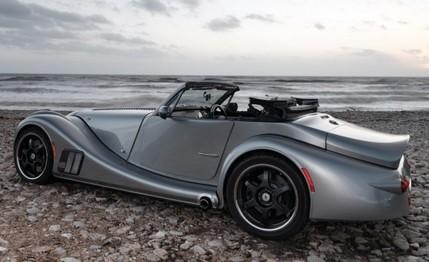
 First Drive Review
First Drive Review
It is difficult for most Americans to fully comprehend the popularity of the Morgan, with its peculiar vintage styling, not to mention the quaint, old-fashioned Britishness of the whole business.
Since 1910, the Morgan Motor Company has been the main employer in the sleepy country town of Malvern Link in Worcestershire, England. It still operates in its original buildings.
Morgans had to provide wind-in-the hair motoring, and they had to be made by hand. In Britain, buyers are even prepared to wait five years from order to delivery.
As Car and Driver first informed readers in the June 1999 issue, a new, thoroughly modern Morgan would be launched at the 2000 Geneva auto show, with deliveries to British customers set to start at the end of the year.
Called the Aero 8, the new Morgan has an aluminum chassis, a state-of-the-art BMW V-8 engine, and advanced features -- at least for Morgan -- such as an independent rear suspension, power steering, and disc brakes at all four wheels. It signals a reorganization that will allow the factory to double production to 24 cars a week, or about 1000 per annum. And that, we are told, is because Morgan is heading for the United States, with this fully certified, crash-tested, air-bagged, and bumper-compliant Aero 8. The target date for its arrival is the summer of 2002.
Creating a high-tech Morgan for the 21st century was tricky. For years, the company rejected the idea of a completely new car as too difficult a task. Besides, it was back-ordered for five years. But in 1996, Charles Morgan, grandson of company founder H.F.S. Morgan, decided to take the plunge.
Racing had shown the potential of an aluminum chassis that could fit under a body of Morgan proportions. That chassis was originally designed by Jim Randle, the former engineering chief of Jaguar, but the development of the Aero 8 has been the work of veteran Morgan tuner and racer Chris Lawrence. The task of shaping a body that would confer stability at speeds as high as 160 mph, yet be unmistakably a Morgan, was taken on by Charles Morgan himself.
Inspired by the classic French and Italian roadsters of the 1930s, Charles did sketches of his ideas for the new car but admits that it was actually shaped by a kind of reverse engineering -- they made it up as they went along. The chassis was there and body parts were made, fitted, and modified, the appearance being approved by the company's small management team at each stage. Sad to say, the result is a car that looks as if it were designed by a committee. The headlight units that are flushed into the wide, sweeping fenders give it a cross-eyed appearance. A large but essential air splitter forms an awkward "shelf" under the dummy traditional radiator grille, and the drooping, squared-off tail is at odds with the generous curves of the front.
So this is a Morgan, but not as we know it. The simple -- and flexible -- steel ladder frame of the old car has been replaced by a stiff, lightweight chassis of 32 aluminum alloy panels, bonded and riveted together, using specially prepared sheetmetal and a construction process developed by Alcan.
The suspension has rocker arms and inboard coil-over shock units instead of the ancient sliding-pillar arrangement at the front, and wide control arms replace the cart-sprung rear axle. Ultralight five-spoke O-Z magnesium alloy wheels are used, 18 inches in diameter and 9.0 inches wide.
Spherical steel joints are used throughout the suspension, with rubber bushings only at the damper mounts. There are two curiosities about the suspension. The coil-over shock units at the rear are "floating" -- both ends are mounted on the control arms, at the outboard end of the lower arm, inboard on the upper -- and there are no anti-roll bars. Lawrence says: "The roll center is low, and I prefer to balance the car's handling with the spring rates."